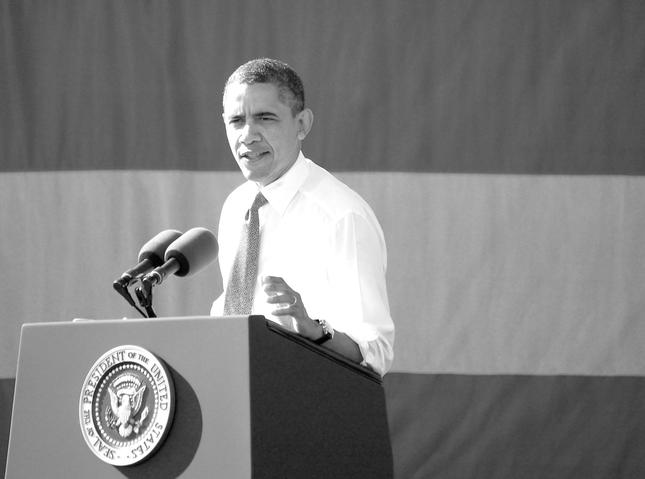“More and more, we all confront difficult questions about how to prevent the slaughter of civilians by their own government, or to stop a civil war whose violence and suffering can engulf an entire region. I believe that force can be justified on humanitarian grounds. . . . Inaction tears at our conscience and can lead to more costly intervention later. That’s why all responsible nations must embrace the role that militaries with a clear mandate can play to keep the peace.” — President Barack Obama
This statement from President Obama could easily be applied to the emerging civil war in Syria, but they were actually spoken at the outset of his administration, on the occasion of his Nobel Peace Prize acceptance. In his speech, he spoke eloquently about “just war,” and “the choice between armed intervention and complicity in oppression.” Both of these messages implicitly embrace an internationalist philosophy that’s widely become known as “Responsibility to Protect,” or “R2P.”
A little over a decade ago, the phrase “responsibility to protect” was introduced by an international commission in an effort to recast the doctrines of “right to intervene” and “obligation to intervene,” while still preserving the intent to act decisively in humanitarian crises. R2P quickly assumed the status of a “norm” (rather than a law) for the United Nations in preventing mass atrocities of the kind witnessed in Rwanda and Bosnia.
A year ago, in his speech justifying the U.S. intervention in Libya, Obama announced that Libya’s assault against its civilian population created a “responsibility” for the international community, stating that “when our interests and values are at stake, we have a responsibility to act.”
Most recently, the U.S. dispatched a special operations force to Uganda to act against one of Africa’s most brutal guerrilla groups.
The precedents in word and deed clearly convey an active endorsement of R2P. However, the true test may lie ahead in our response to Syria’s ongoing repression.
R2P has evolved with a set of defining “pillars,” “thresholds” and “obligations.” Entire non-governmental organizations have since been built around R2P. It even has its own Twitter hash-tag with a host of followers, to include billionaire George Soros and actress Mia Farrow — all of the necessary marketing ingredients for a presidential doctrine, ready-made.
R2P has strong advocates within the Obama administration, including Susan Rice, the U.S. ambassador to the UN, and Samantha Power, the National Security Council’s senior director, widely considered one of the principal architects of the Libya intervention.
In short, R2P shatters the premise that sovereignty, in the strict Westphalian sense is inviolable, arguing instead that it is a responsibility. According to R2P, every state has a responsibility to protect its population from mass atrocities. If they can’t do it themselves, the international community is obligated to assist them — even if they don’t want the help. Once peaceful measures like economic sanctions have failed, the international community has the responsibility to intervene militarily — but only as a last resort and only if the UN Security Council authorizes it.
In a narrative reminiscent of St. Augustine’s letter to Boniface outlining what would ultimately become the foundation for Just War theory, R2P advocates that all military interventions must fulfill six broad criteria:
• Just Cause
• Right Intention
• Final Resort
• Legitimate Authority
• Proportional Means
• Reasonable Prospect
Even a cursory review of President Obama’s speech justifying our Libya intervention last year shows a close alignment — even synchronization — with these criteria.
While circumventing Congress is nothing new for presidents, what is noteworthy in the case of Libya is Obama’s apparent effort to elevate R2P as a universal principle that not only trumps traditional perceptions of national sovereignty but also transcends the constitutional tenets that give Congress the sole authority to declare war.
Whether the president will declare his official sponsorship of R2P remains to be seen, but the language of his recent speeches and the actions of his administration make it clear that R2P is indeed a cornerstone of his foreign policy. A telling indicator will be whether he is willing to give R2P even more prominence by intervening militarily in Syria without UN Security Council approval.
While some may hail a unilateral NATO campaign against Syria as further strengthening R2P, the irony is that it could actually weaken it. Just as inconsistency or failure to act in humanitarian crises can diminish an R2P-based policy, any perception of “R2P-as-Subterfuge” for Western national self-interests (crushing the Iran-Syria-Hezbollah axis, for instance), could have devastating affects for the broad R2P construct, long term.
In the coming months, Obama’s action or inaction on Syria will largely determine whether R2P is to remain a UN norm or if it will ultimately emerge as the “Obama Doctrine.” It’s a topic being discussed by administration strategists — and the whispers outside the White House gates have already begun. Yet, a more fundamental, if not practical, question for those West Wing discussions will be whether an R2P policy is sustainable in a time when defense budgets are dramatically declining.


